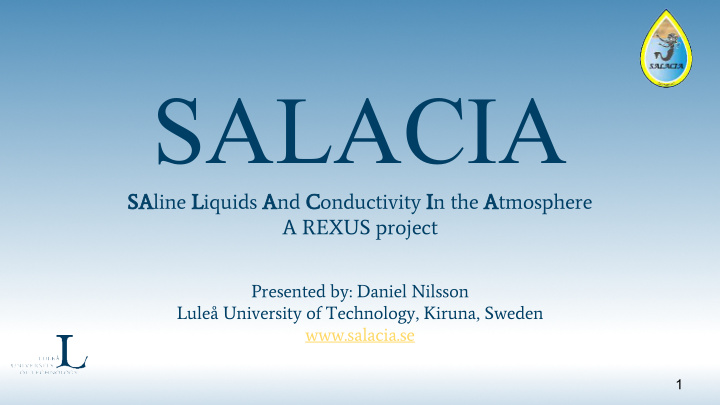



SALACIA SAline Liquids And Conductivity In the Atmosphere A REXUS project Presented by: Daniel Nilsson Luleå University of Technology, Kiruna, Sweden www.salacia.se 1
Outline • The REXUS/BEXUS program • Scientific background • The SALACIA mission • Discussion 2
The REXUS/BEXUS program “The REXUS/BEXUS programme is realized under a bilateral Agency Agreement between the German Aerospace Center (DLR) and the Swedish National Space Board (SNSB). The Swedish share of the payload has been made available to students from other European countries through a collaboration with the European Space Agency (ESA).” 1 1. www.rexusbexus.net 3
REXUS timeline - 8.5 m - 18 m - 15.5 m - 15 m - 4 m + 0 Student Call for ESTEC Final Integration Training Launch proposals workshop selection week Week 4
Scientific Background Credits: Martin-Torres & Zorzano 5
Scientific Background Credits: Martin-Torres & Zorzano time 6
The SALACIA mission Salt behavior and conductivity ■ under stress ■ low pressure ■ low Relative Humidities (RH) ■ different temperatures Designing an instrument to study perchlorates (on Mars and Earth) 7
Experiment Design Layout view for SALACIA experiment 8
Mechanical structure 5 vessels, each have a volume of ~9000 mm 3 Cylindrical shape of the vessels (not yet determined), mass below 2kg Take advantage of counterclockwise spin Current preliminary design Old design 9
Electrical structure 1 microcontroller unit with a power consumption of about 20mA- • 50mA 1 power supply unit with an estimated power dissipation of ~37 mA • Conductivity sensors are estimated to consume, at worst case ~200 • mA • Heating with power resistor of 100 Ohm, power consumption of 0.3 A, (10W) The total current drawn, with a 20% adding to the MCU and PSU, is • estimated to be ~76 mAh (if the time of flight is ~800 seconds) • The camera system will have its own battery 10
Expected results Credits: Martin-Torres & Zorzano 11
The SALACIA Team 16 members Studying space technology in Kiruna, Sweden Supported by Luleå University of Technology 12
Discussion • Post-flight examination • Conductivity measurements • Oxidizing salts • Laminar flow 13
Thank you ! Read more at: www.salacia.se 14
Additional Slides 15
Motivation 16
Recommend
More recommend